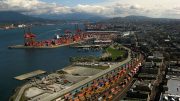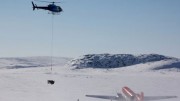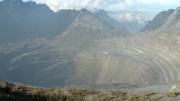While copper prices continued to weaken substantially in early June, falling again below US$3 per lb., there were significant new copper developments on the supply side.
• On June 6, hundreds of riot-gear-clad federal Mexican police using teargas and helicopters retook physical control of Grupo Mexico’s Cananea copper mine site in Mexico’s Sonora state from local unionized workers. They have been on strike at the mine for almost three years, citing health and safety concerns.
Cananea was Mexico’s biggest copper mine before the work stoppage, and cranked out 190,000 tonnes of copper per year at full capacity, or about 40% of Mexican copper output. With the asset back in company hands, Grupo Mexico intends to refurbish the mine and have it up and running again perhaps by the end of the year, likely using replacement workers.
Grupo Mexico reckoned in February that it had lost US$1.5 billion in costs and missed revenue opportunities owing to the strike, which has also held up a planned expansion of Cananea’s annual copper-production capacity to 460,000 tonnes.
The company says the strike has also contributed to delays in advancing its US$2-billion El Arco copper project in Baja California, as it may make use of Cananea for downstream processing. It’s no small matter: an expanded Cananea and an operational El Arco would turn Mexico into the world’s second-largest copper producer.
The national government ordered the police action in response to a court ruling earlier this year that stated striking workers at Cananea could be fired, but some speculate the mine-site seizure had been delayed until after Mexican President Felipe Calderon’s recent visit to the U.S. and Canada, so that he would avoid a scolding by the union-backed U.S. President Barack Obama.
The police action has, of course, infuriated the striking union members and their supporters in town, as well as Mexico’s national mining union, which is backed by U.S. and Canadian members of the United Steelworkers union. (Indeed, the head of the Mexican mining union, Napoleon Gomez Urrutia, fled the country years ago to avoid what the union considers trumped-up embezzlement charges and now operates out of the Steelworkers’ office in the Vancouver suburb of Burnaby.)
“The national mining union holds President Felipe Calderon’s government responsible for any violence or bloodshed that may happen now and demands a reversal of this illegal, military invasion,” the union said in a statement reported by Reuters.
A few hours after the Cananea action, in the middle of the night, Mexican police in Coahuila state carried out a similar recapture of Grupo Mexico’s Pasta de Conchos mine site, which was also under union members’ control. The mine has been closed since 2006, when a massive explosion killed 65 workers.
Cananea and Pasta de Conchos remain potent symbols of both union power and grievances in Mexico, and it’s reasonable to expect a major backlash from Mexican unions against these latest events.
• In British Columbia, member of provincial parliament Blair Lekstrom tendered his resignation as Minister of Energy, Mines and Petroleum Resources to protest his government’s imminent implementation of the harmonized sales tax (HST) — a merging of the provincial and federal good and services taxes that will result in higher total taxes for consumers. Premier Gordon Campbell quickly named Bill Bennett of Kootenay East as a replacement. If that name sounds familiar, Bennett was previously Minister of Community and Rural Development, and served as Minister of State for Mining from 2005 to 2007. Randy Hawes is still Minister of State for Mining.
Unlike Ontario, where citizens roll over in response to tax increases and the politicians’ lies that herald them, the HST has become a major issue in B.C. politics. The socialist and anti-mining provincial New Democratic Party is, ironically enough, one of the loudest voices against the new tax, and looks to be one of the major beneficiaries of anti-tax sentiment in the next provincial election.
• For comic relief, we had The New York Times running a breathless feature by a Washington, D.C., staffer on the boundless mineral potential of one of the world’s great basket cases, entitled, “U. S. identifies vast mineral riches in Afghanistan.”
The article had such gems as “the United States has discovered nearly $1 trillion in untapped mineral deposits in Afghanistan, far beyond any previously known reserves…” and “Afghanistan could eventually be transformed into one of the most important mining centers in the world…”
As always, crudely put, if it costs a trillion dollars to mine minerals that can be sold for a trillion dollars, then the value of the mineral deposits is zero dollars, not a trillion, and they’ll never be developed.
Send your Letters-to-the-Editor and other op-ed submissions to the Editor at: tnm@northernminer.com, fax: (416) 510-5137, or 12 Concorde Pl., Suite 800, Toronto, ON M3C 4J2.





Be the first to comment on "Editorial: Cananea retaken"